The Different Types of Concrete Mixer Machines

In the construction industry, concrete is one of the most commonly used building materials. Whether it's for a new construction project or a renovation, a concrete mixer is an indispensable piece of equipment. Understanding the different types of concrete mixers can help you make a more informed choice during the construction process.
What is a concrete mixer?
A concrete mixer is a construction machine designed to mix cement, water and other materials (such as sand, gravel and additives) together to make concrete. Depending on the use scenario, concrete mixers can be categorised as stationary or portable, with sizes ranging from small portable mixers to large industrial mixers. By using concrete mixers, construction sites are able to save time and labour and increase productivity by providing workers with plenty of time to use the mixture before it sets.
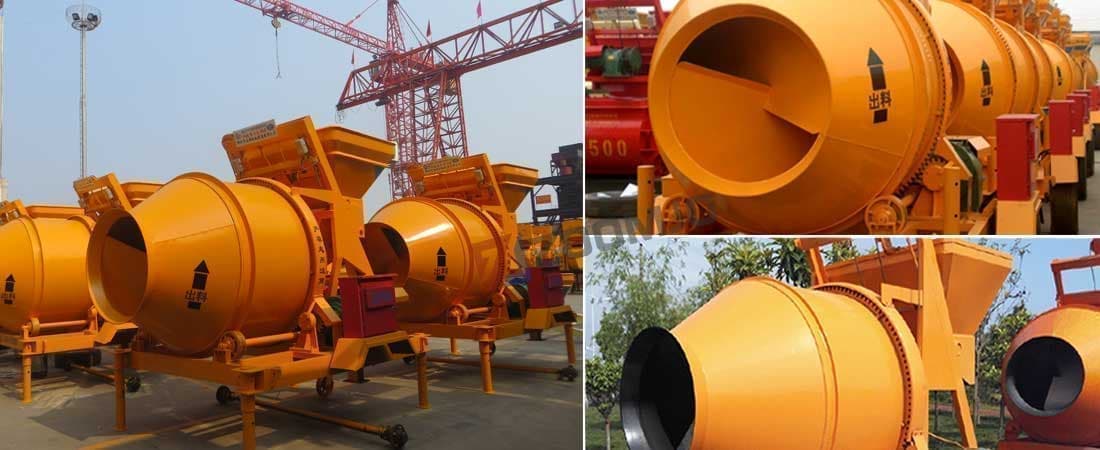
Common types of concrete mixers
Concrete mixers are divided into two main categories: batch mixers and continuous mixers. Below is a detailed description of these two types of mixers.
Concrete batch mixer
A concrete batch mixer (also known as an intermittent concrete mixer) is a device that mixes concrete in batches according to pre-set ratios and quantities. It works differently from a continuous mixer: a batch mixer can only mix a certain amount of concrete at a time, and after mixing, the concrete must be discharged before the next batch can be mixed.
Batch mixers are typically used for small to medium sized construction projects and can mix a specific volume of concrete at a time. Its basic structure is a drum or container into which all raw materials (e.g., cement, sand, gravel, water, etc.) are added in a predetermined sequence. Batch mixers are available in a wide range of sizes in order to meet the concrete dosage requirements of different projects. The maximum capacity of a small mixer is usually about 1 cubic metre, while a large mixer can have a capacity of 6 cubic metres or even more.
The following are the main types of concrete batch mixers that are commonly used:
1. Disc-type concrete mixers
The disc type concrete mixer is named for its circular mixing disc. It is characterised by a rotating mixing disc, which drives the materials to be mixed, and is capable of producing concrete mixtures with high homogeneity, which are suitable for many types of concrete proportioning. However, due to the limitation of its mixing method, the mixing capacity is relatively low, so it is more suitable for small and medium-sized projects or prefabricated component factories, rather than for large-scale construction projects that require large-capacity mixing equipment.
-
Advantages: Good mixing uniformity, simple structure and easy maintenance.
-
Disadvantages: Relatively small mixing capacity, relatively low efficiency.
-
Scope of application: Small and medium-sized projects, prefabricated component factories, etc.
2. drum mixer
Drum mixer, also known as drum mixer, is a type widely used in engineering, mainly used for mixing larger quantities of concrete or mortar. It consists of a drum rotating in the centre of its axis, with mixing blades or fins inside, and the mixing of materials is achieved through the rotation of the drum and the stirring of the blades, which is capable of mixing concrete efficiently. According to the different ways of discharging, drum mixers can be further classified into the following categories:
Tiltable Drum Mixer
Tiltable drum mixer realises fast discharging through the design of tiltable drum, which significantly improves the construction efficiency and is especially suitable for projects requiring continuous pouring. Its main advantages are fast unloading speed and high efficiency, which can effectively shorten the construction period. However, the structure of this kind of mixer is relatively complicated and the manufacturing cost is high, so the actual demand and budget of the project need to be considered comprehensively when choosing.
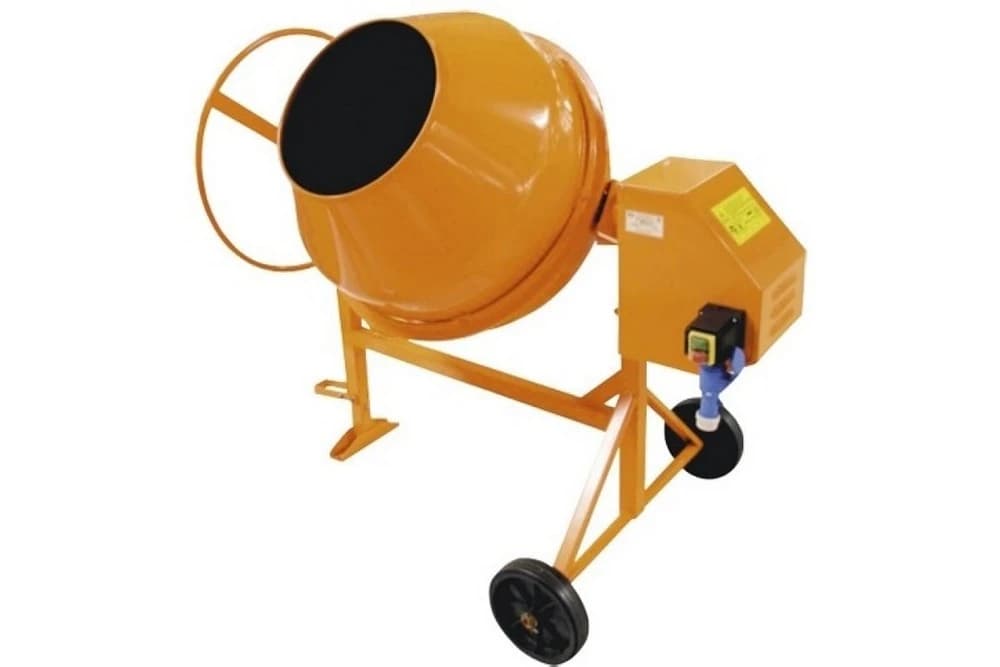
Non-dumping drum mixer
Non-tilting drum mixers do not have tilting drums and usually require manual or other auxiliary equipment to discharge the material. The advantages of this type of mixer are simple structure, easy maintenance and low cost, which is very suitable for small and medium-sized construction projects, such as rural self-built houses and other scenarios. However, its disadvantages are also more obvious, that is, the unloading speed is slow, the overall construction efficiency is relatively low.
Reverse Drum Mixer
The unique feature of the Reverse Drum Mixer is that the drum can rotate in both directions, forward for mixing and reverse for discharging. This design enables it to effectively mix various types of concrete, including plastic, dry and flowable concrete, and can meet the needs of projects that require high uniformity of concrete. Its advantages are good mixing effect and wide range of application, but the disadvantage is that the structure is more complicated than other types of drum mixers.
When buying a reversing drum mixer, the choice of diesel or electric drive depends on the usage scenario.
-
Diesel-driven: Advantages are high mobility, no external power supply, suitable for field, remote areas and emergency projects; high power, suitable for mixing large capacity or high viscosity concrete; strong environmental adaptability. Disadvantages are noisy; high maintenance cost; exhaust gas pollution; may be difficult to start in cold weather.
-
Electric drive: Advantages are low noise; low maintenance cost; clean and environmentally friendly; easy to start. Disadvantages are dependence on electricity supply, not suitable for sites without electricity or unstable electricity; limited mobility; power may be relatively low, not always suitable for large capacity or special concrete.
-
How to choose: If the construction site has stable and convenient electricity, electric drive is preferred; if there is no electricity or unstable electricity, diesel drive is preferred. Large-scale projects or special concrete projects usually need more power diesel drive; small and medium-sized projects or fixed places, electric drive is more appropriate. Where environmental protection requirements are high, electric drive should be preferred. In terms of budget, the purchase and maintenance costs of diesel engines are usually higher.
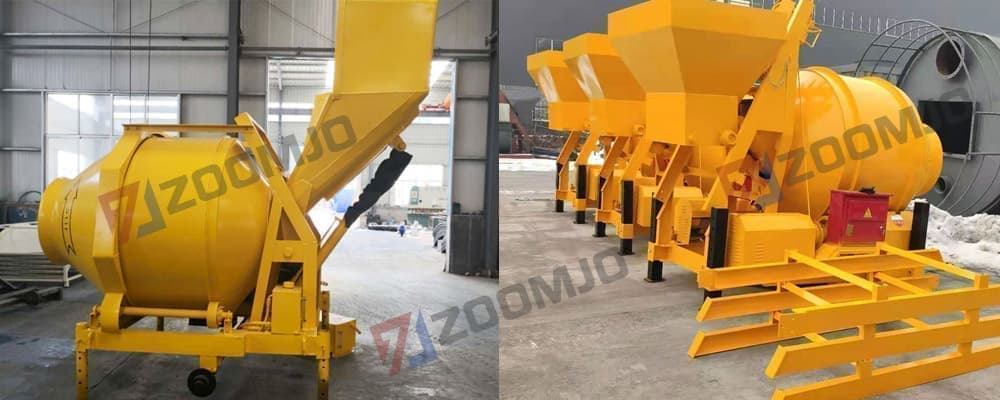
Apart from the above two common types, there are some other types of concrete batch mixers such as:
Forced mixers
This kind of mixer is used for forced mixing of materials through the rotating mixing blades or mixing arms in the mixing drum, which has high mixing efficiency and good mixing quality, and is suitable for mixing high grade concrete and special concrete. The forced mixer can be subdivided into single horizontal shaft, double horizontal shaft and vertical shaft planetary type. Although usually used in mixing plants, there are some small forced mixers belonging to batch type.
Continuous mixers
A continuous mixer is a type of industrial mixing equipment that is characterised by a continuous flow of material into the mixer, which is mixed and then continuously discharged. Unlike intermittent mixers, continuous mixers do not need to stop or empty the vessel for the next batch to be mixed, making them more productive and more suitable for large-scale, continuous production processes.
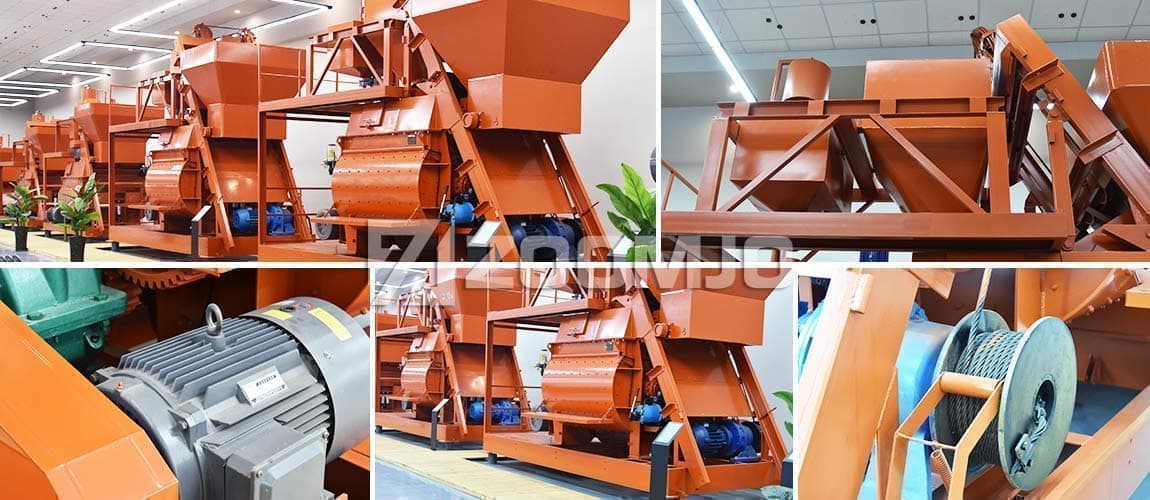
Working Principle
The working principle of continuous mixer is to send all kinds of materials into the mixer cylinder continuously through the conveying device (such as belt conveyor, screw conveyor, etc.) according to the predetermined proportion. In the cylinder, the mixing device (such as mixing blade, propeller, etc.) continuously mixes the materials, and after reaching the state of uniform mixing, the mixed materials are continuously discharged from the discharge port. The residence time of the material in the cylinder is controlled by adjusting the parameters of conveying speed, mixing speed and discharging speed.
Main components:
-
Feeding system: including silo, hopper, conveyor, etc. It is responsible for feeding all kinds of materials into the mixer continuously according to the proportion.
-
Mixing cylinder: It is the main place for mixing materials and is equipped with mixing device inside.
-
Mixing device: including mixing shaft, mixing blade, propeller and so on, responsible for mixing materials.
-
Driving device: including motor, reducer, etc., to provide the necessary power for mixing.
-
Discharge system: responsible for discharging the mixed materials continuously.
-
Control system: responsible for controlling the whole mixing process, including feeding speed, mixing speed, discharging speed and other parameters.
Type:
Continuous mixer is mainly applied in the field of concrete mixing with the following two types:
Continuous double horizontal shaft mixer
Continuous double horizontal shaft mixer and continuous single horizontal shaft mixer. Double horizontal shaft mixer is usually equipped with two parallel horizontal mixing shafts, the shafts are equipped with multiple sets of mixing blades, the material enters into the mixing cylinder continuously from the inlet, and is forced to mix under the synergistic action of the twin shafts, and is discharged continuously from the discharge port. It is characterised by high mixing efficiency, double shaft design and dense blade arrangement to ensure efficient mixing of materials and uniformity of concrete; large handling capacity, suitable for large-scale continuous production, high output; strong adaptability, can mix various types of concrete, including ordinary concrete, dry hard concrete and high-performance concrete, etc. It is commonly used in large-scale concrete mixing plants, highways, large-scale water conservancy projects, etc., which need to be continuously, It is commonly used in large-scale concrete mixing plant, highway, large-scale water conservancy project and other occasions that require continuous and large amount of concrete supply.
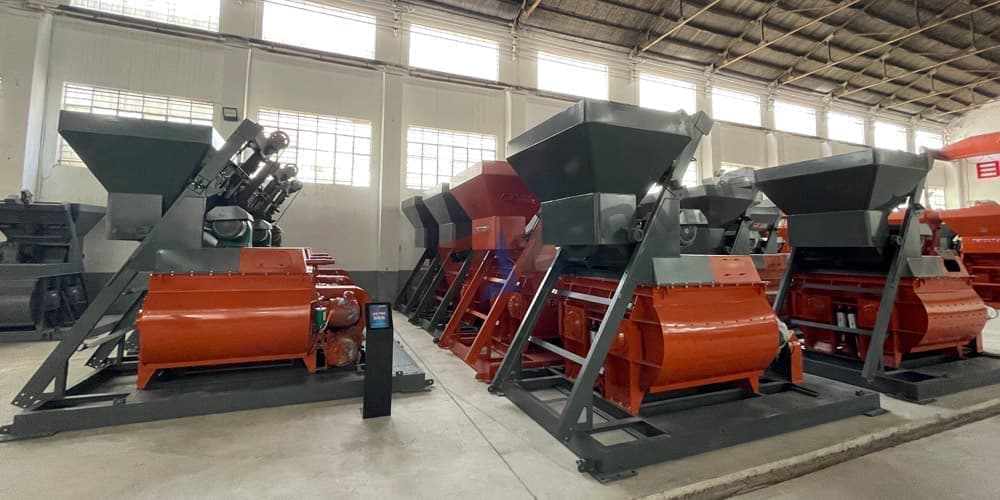
Continuous Single Horizontal Shaft Mixer
In contrast, the single horizontal shaft mixer has only one horizontal mixing shaft, the shaft is equipped with mixing blades, the material continuously enters into the mixing cylinder, mixes and discharges through the rotation of the mixing shaft. Its characteristics are relatively simple structure, compared with the double horizontal shaft mixer, the structure is simpler, maintenance is relatively easy; lower cost, manufacturing cost and operating cost is relatively low; relatively small capacity, compared with the double horizontal shaft mixer, the capacity is smaller, suitable for medium-sized continuous production, so it is commonly used in small and medium-sized prefabricated components factory, commercial concrete mixing plant, and so on.
Summary
In conclusion, each mixer has its advantages and disadvantages, and the selection of the right mixer depends on the specific requirements of the construction project, including the project scale, concrete type, construction site, budget, etc. When choosing a concrete mixer, the following factors must be considered comprehensively:
-
Mixing capacity: That is, the maximum mixing capacity of the mixer, which is selected according to the amount of concrete required for the project.
-
Mixing speed: affect the mixing efficiency and construction progress.
-
Mixing efficiency: refers to the amount of concrete mixed per unit of time, as well as the uniformity of concrete.
-
Versatility: The ability to mix different types of concrete or other building materials.
-
Energy consumption: The energy consumption of the equipment.
-
Maintenance and servicing: How easy it is to maintain the equipment and how much it costs to maintain.
-
Price: The purchase cost of the equipment.
By considering the above factors, you can select the most suitable mixer for a particular construction project, thus improving construction efficiency and ensuring project quality.

 English
English  Español
Español  简体中文
简体中文  Pусский
Pусский  українська
українська 
